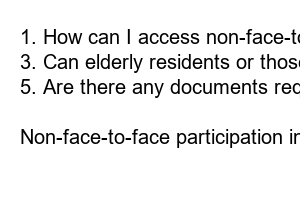주민등록 사실조사 비대면 참여
Title: Non-Face-to-Face Participation in Resident Registration Fact-Finding: A Modern Approach to Streamlining Administrative Processes
Introduction:
In this digital era, the way we interact and engage with various spheres of life is rapidly changing. One such area that has experienced a significant transformation is resident registration fact-finding. The advent of non-face-to-face participation has revolutionized the administrative processes involved, offering convenience, efficiency, and speed. Let’s delve deeper into this modern approach and explore its myriad benefits.
1. Understanding Non-Face-to-Face Participation:
Non-face-to-face participation refers to the method of gathering necessary information from residents without requiring physical presence. Instead, technology acts as a bridge, allowing residents to contribute to resident registration processes from the comfort of their own homes.
2. How Does Non-Face-to-Face Participation Work?
Residents can participate in non-face-to-face fact-finding through various online platforms, such as websites or mobile applications. These platforms facilitate the submission of required documents and relevant information, with clear instructions guiding residents through the process step-by-step.
3. The Advantages of Non-Face-to-Face Participation:
Embracing non-face-to-face participation brings several benefits to both residents and administrative bodies. The most notable advantages include:
– **Convenience:** Eliminating the need for physical visits, residents can complete the fact-finding process at their convenience, without time constraints. This allows busy individuals to save valuable time and effort.
– **Efficiency:** The digital format simplifies and accelerates the entire process, reducing paperwork and eliminating lengthy queues. By streamlining administrative tasks, non-face-to-face participation ensures faster turnarounds and quicker responses.
– **Accessibility:** This approach empowers individuals who may have mobility limitations or reside in remote areas, ensuring that everyone has an equal opportunity to participate in fact-finding activities.
4. Addressing Security Concerns:
Non-face-to-face participation employs stringent security measures to protect sensitive information. Platforms utilize encryption techniques and secure servers to safeguard data from unauthorized access. The use of unique identifiers and verification procedures further enhances the security of residents’ personal information.
5. Overcoming Challenges and Limitations:
While non-face-to-face participation offers numerous advantages, it is essential to address potential challenges. Educating residents about the process, addressing technological barriers, and providing reliable support channels are vital to ensuring a smooth transition and widespread acceptance of this modern approach.
6. The Future of Non-Face-to-Face Participation:
As technology continues to advance, non-face-to-face participation is poised to become the norm across an array of administrative processes. The integration of artificial intelligence, automation, and blockchain technology promises further enhancements in efficiency, accuracy, and security.
FAQs:
1. How can I access non-face-to-face participation platforms?
2. Is my personal information secure while participating online?
3. Can elderly residents or those unfamiliar with technology use this system?
4. What happens if I encounter technical issues during the non-face-to-face process?
5. Are there any documents required for non-face-to-face participation?
6. Can I opt for non-face-to-face participation for all resident registration procedures?
Summary:
Non-face-to-face participation in resident registration fact-finding is a groundbreaking development that offers numerous benefits to both residents and administrative bodies. Through convenient, secure, and efficient digital platforms, individuals can participate in the process seamlessly. As we embrace this modern approach, we can expect an evolution in administrative practices, ensuring a more streamlined and accessible future for all.

